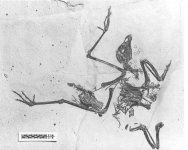Fred Ruhe
Well-known member

Daniel J. Field and Allison Y. Hsiang, 2018
A North American stem turaco, and the complex biogeographic history of modern birds
BMC Evolutionary Biology (2018) 18:102
Free pdf https://bmcevolbiol.biomedcentral.com/track/pdf/10.1186/s12862-018-1212-3
Abstract:
Background: Earth’s lower latitudes boast the majority of extant avian species-level and higher-order diversity, with many deeply diverging clades restricted to vestiges of Gondwana. However, palaeontological analyses reveal that many avian crown clades with restricted extant distributions had stem group relatives in very different parts of the world.
Results: Our phylogenetic analyses support the enigmatic fossil bird Foro panarium Olson 1992 from the early Eocene (Wasatchian) of Wyoming as a stem turaco (Neornithes: Pan-Musophagidae), a clade that is presently endemic to sub-Saharan Africa. Our analyses offer the first well-supported evidence for a stem musophagid (and therefore a useful fossil calibration for avian molecular divergence analyses), and reveal surprising new information on the early morphology and biogeography of this clade. Total-clade Musophagidae is identified as a potential participant in dispersal via the recently proposed ‘North American Gateway’ during the Palaeogene, and new biogeographic analyses illustrate the importance of the fossil record in revealing the complex historical biogeography of crown birds across geological timescales.
Conclusions: In the Palaeogene, total-clade Musophagidae was distributed well outside the range of crown Musophagidae in the present day. This observation is consistent with similar biogeographic observations for numerous other modern bird clades, illustrating shortcomings of historical biogeographic analyses that do not incorporate information from the avian fossil record.
Keywords: Biogeography, Palaeontology, Turaco, Musophagidae, Phylogeny, Fossils, Gondwana, Dispersal, Otidimorphae, Macroevolution
Enjoy,
Fred
A North American stem turaco, and the complex biogeographic history of modern birds
BMC Evolutionary Biology (2018) 18:102
Free pdf https://bmcevolbiol.biomedcentral.com/track/pdf/10.1186/s12862-018-1212-3
Abstract:
Background: Earth’s lower latitudes boast the majority of extant avian species-level and higher-order diversity, with many deeply diverging clades restricted to vestiges of Gondwana. However, palaeontological analyses reveal that many avian crown clades with restricted extant distributions had stem group relatives in very different parts of the world.
Results: Our phylogenetic analyses support the enigmatic fossil bird Foro panarium Olson 1992 from the early Eocene (Wasatchian) of Wyoming as a stem turaco (Neornithes: Pan-Musophagidae), a clade that is presently endemic to sub-Saharan Africa. Our analyses offer the first well-supported evidence for a stem musophagid (and therefore a useful fossil calibration for avian molecular divergence analyses), and reveal surprising new information on the early morphology and biogeography of this clade. Total-clade Musophagidae is identified as a potential participant in dispersal via the recently proposed ‘North American Gateway’ during the Palaeogene, and new biogeographic analyses illustrate the importance of the fossil record in revealing the complex historical biogeography of crown birds across geological timescales.
Conclusions: In the Palaeogene, total-clade Musophagidae was distributed well outside the range of crown Musophagidae in the present day. This observation is consistent with similar biogeographic observations for numerous other modern bird clades, illustrating shortcomings of historical biogeographic analyses that do not incorporate information from the avian fossil record.
Keywords: Biogeography, Palaeontology, Turaco, Musophagidae, Phylogeny, Fossils, Gondwana, Dispersal, Otidimorphae, Macroevolution
Enjoy,
Fred




